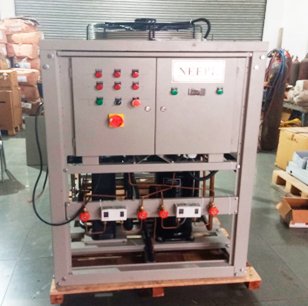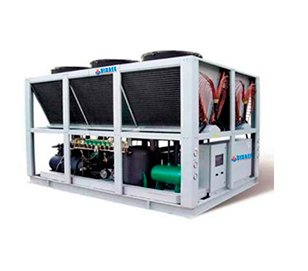


Air Cooled Chiller is a type of cooling system used to remove heat from a liquid via a vapor-compression or absorption refrigeration cycle. It is commonly used in commercial, industrial, and institutional facilities to cool machinery, products, or the building itself.
Key Components
-
Compressor: Compresses refrigerant to increase its pressure and temperature.
-
Condenser Coils: Transfer heat from the refrigerant to the outside air.
-
Expansion Valve: Reduces the pressure of the refrigerant, causing it to cool rapidly.
-
Evaporator: Transfers heat from the process water to the refrigerant, cooling the water.
-
Fans: Blow air over the condenser coils to facilitate heat dissipation.
-
Refrigerant: A fluid that absorbs heat during evaporation and releases it during condensation.
Working Principle
-
Heat Absorption: The process fluid (like water) passes through the evaporator, transferring its heat to the refrigerant.
-
Refrigeration Cycle:
-
The refrigerant evaporates, absorbing heat from the process fluid.
-
The compressor increases the refrigerant’s pressure, raising its temperature.
-
The heated refrigerant releases heat to the atmosphere as it condenses in the condenser coils.
-
The expansion valve lowers the refrigerant pressure, and the cycle repeats.
-
Applications
-
Industrial: Used in manufacturing processes, such as plastic molding, food processing, and chemical production.
-
HVAC: Provide cooling for buildings, data centers, and hospitals.
-
Cooling Equipment: Maintain optimal conditions for industrial machines and equipment.
